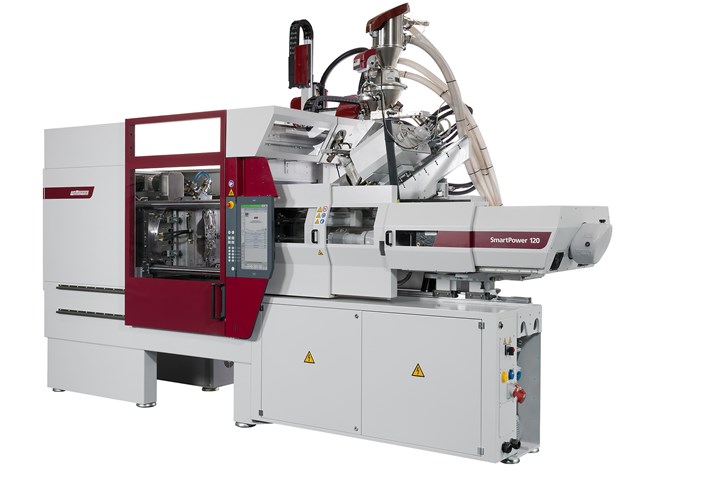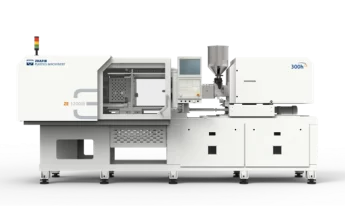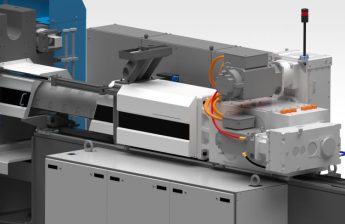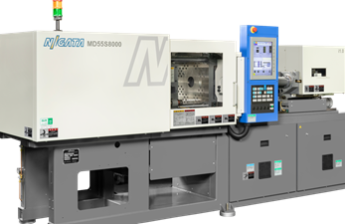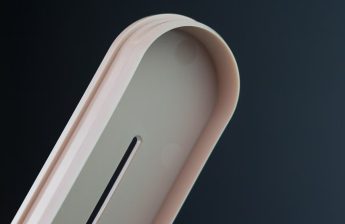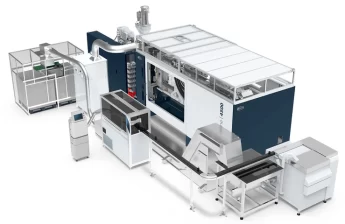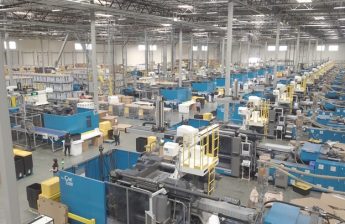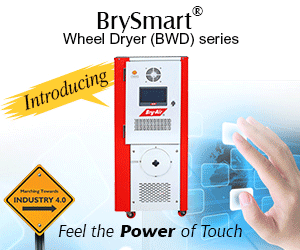In addition to all-electric machine models from the EcoPower and MicroPower series, Wittmann Battenfeld shows a servo-hydraulic SmartPower with an electric injection unit for the first time at Fakuma 2024. A company spokesperson told Plastics Technology that for a standard one-component servo-hydraulic SmartPower, the machine’s clamp is servo hydraulic and the screw is electric. The company is now offering an electric injection unit as an option.
For the two-component (2K) machine at Fakuma 2024, the main injection unit is electric, while the auxiliary injection unit is servo hydraulic. The machine is molding a bottle opener at the show, with the larger electric injection unit shooting the PC substrate and the servo-hydraulic auxiliary unit overmolding TPE onto the PC part.
Wittmann says the optional electric injection unit enables the machine to combine the advantages of the servo-hydraulic SmartPower’s larger mold space with the all-electric EcoPower’s highly dynamic regulation and shot-to-shot consistency.
At Fakuma, a Combimould SmartPower B8X 120/350H/130S with an electric injection unit makes the aforementioned PC and TPE bottle opener on a tool from FKT Formenbau und Kunststofftechnik. The SmartPower features the Insider beside-the-press granulation and scrap reintroduction system, as well as a W918 robot and integrated conveyor. The robot inserts the metal parts fed from a magazine into the mold, where they are overmolded with polycarbonate. The PC and metal substrate is passed on to a second station by a rotary unit and overmolded with TPE. Finished parts are deposited on the conveyor within the Insider cell.
Building on its foray into DC energy as a power source for injection molding, the cell’s temperature control unit, as well as the machine and the robot, are all powered via direct current. Wittmann says further DC-compatible auxiliary appliances are in the works.
Elsewhere at the booth, an EcoPower B8X 180/750 DC Insider cell with an integrated WX142 robot in DC and DC-compatible Tempro plus D temperature controller will mold the housing for a plug-in connector for DC technology, using a 2-cavity mold supplied by Harting. One of these finished connectors from Harting is built into the machine and used to connect the Tempro plus DC appliance to it. Wittmann notes that previously fixed wiring was typically required for safety reasons, but now a simpler plug-in connection can be used instead.
Salt battery technology applying a sodium-nickel basis from innovenergy is used to power the system. The battery has a total capacity of more than 45 kWh, enabling uninterrupted machine operation throughout the 8-hour trade fair day. In addition, electrochemical capacitors, known as supercaps, are used to complement the sodium-nickel storage units by balancing out short-term load peaks. Both the robot and the temperature controller will be powered directly via the EcoPower’s DC voltage interim circuit. The injection molding machine as well as the robot will also return any excess deceleration energy from the axes to the interim circuit.
An EcoPower B8X molds darts tips out of POM from a 32-cavity Hasco mold. The mold is equipped with a pneumatic needle shut-off nozzle, and the parts are removed by a Wittmann robot and fed to a tubular bag system supplied by Ravizza Packaging.
Wittmann says the machine’s dynamic operation is achieved via an optimized toggle. The encapsulated system is filled with gear oil and features a separate oil compartment for the drive unit and ball screw drive. The machine’s Unilog B8X control system, developed by Wittmann, has higher clock frequency to further enhance the machine’s precision and speed.
In micro injection molding, a MicroPower 15/10 machine with a two-stage screw-and-piston injection unit will mold demo tiles measuring 8.5 × 8.5 mm. These tiles, produced on a 4-cavity mold with nano structures fabricated by 3D printing and supplied by NanoVoxell, feature a world map showing the locations of Wittmann’s production sites.
Elsewhere at the booth of Nexus Elastomer Dosing and Nexus Elastomer Molds, an EcoPower B8X 110/350 LIM machine shows silicone molding of syringe piston stoppers from an 8-cavity series production mold, equipped with a Nexus Timeshot needle shut-off system. A Nexus Servomix X200 dosing system handles LSR supply, with a Servomix X1 booster unit delivering the LSR material components to the molding machine.
Source: ptonline.com

